Shrimp Mei Fun is a delectable Chinese noodle dish that combines succulent shrimp, tender rice noodles, and an array of vibrant vegetables.
In this article, we will delve into the world of Shrimp Mei Fun recipes, exploring its origins, and flavors, and providing you with a step-by-step guide to recreate this mouthwatering dish in the comfort of your own kitchen. Get ready to tantalize your taste buds with the exquisite flavors of Shrimp Mei Fun!
What is shrimp mei fun?
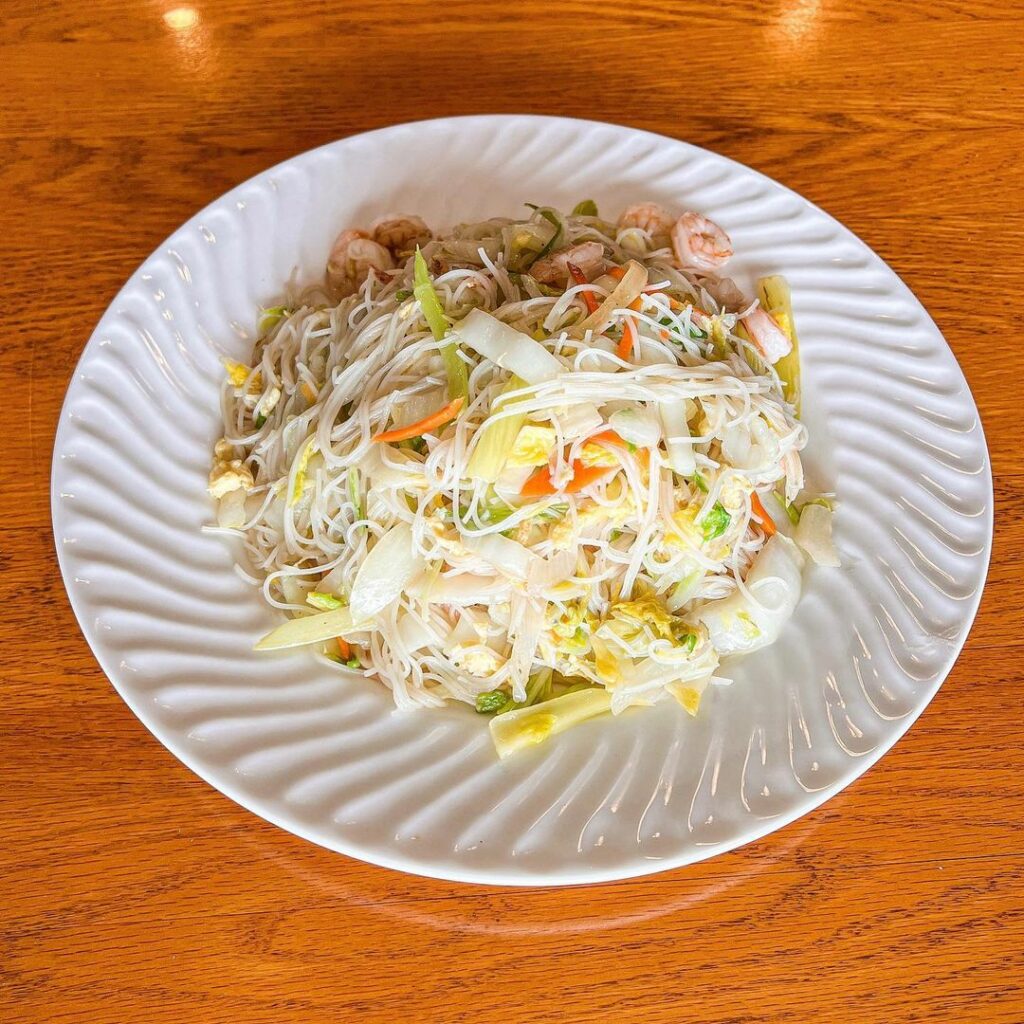
Shrimp Mei Fun is a beloved Chinese noodle dish that features thin rice noodles stir-fried with succulent shrimp, assorted vegetables, and aromatic seasonings. It is a popular and flavorful option in Chinese cuisine, known for its harmonious combination of textures and flavors.
Shrimp Mei Fun is a testament to the culinary creativity and expertise of Chinese chefs, showcasing the skillful use of ingredients to create a satisfying and delicious meal. As the name suggests, shrimp is a key component of this dish, adding a delicate seafood flavor and protein-rich goodness.
The shrimp used in Shrimp Mei Fun can come from various sources, including freshwater and saltwater environments, depending on the region and availability. Whether enjoyed in a bustling Chinese restaurant or prepared at home, Shrimp Mei Fun offers a delightful dining experience that celebrates the artistry and diversity of Chinese cuisine.
What does shrimp mei fun taste like?
Shrimp Mei Fun delights the palate with its unique blend of flavors and textures. The dish offers a harmonious combination of succulent shrimp, delicate rice noodles, and a medley of vibrant vegetables.
The shrimp imparts a subtle seafood sweetness, complemented by the umami notes of soy sauce and other seasonings. The rice noodles provide a soft and chewy texture, while the vegetables add a refreshing crunch. The dish’s overall taste is savory, balanced, and deeply satisfying.
Each bite offers a symphony of flavors, with the ingredients and seasonings working together to create a memorable dining experience. Whether you savor it in a restaurant or prepare it at home, Shrimp Mei Fun promises to transport your taste buds to a world of delightful flavors.
Shrimp mei fun recipe
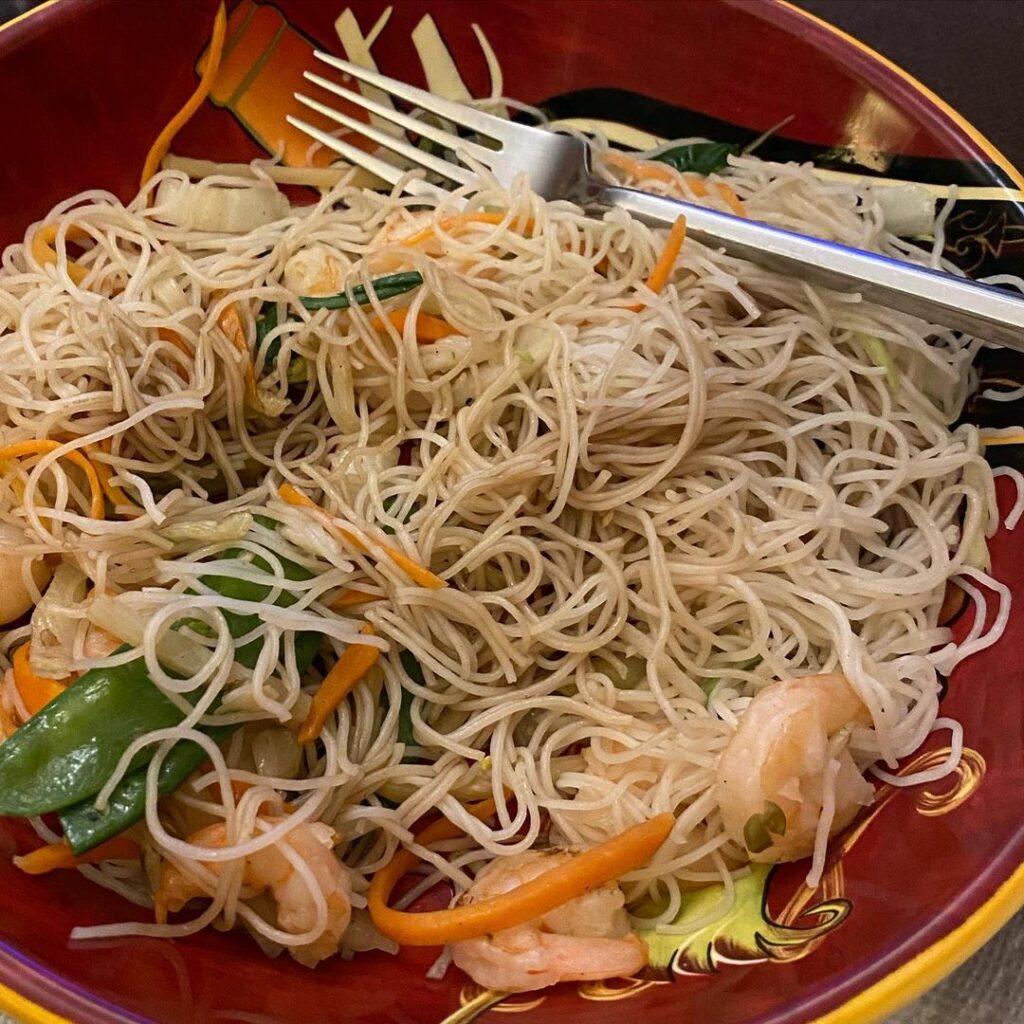
The Chinese shrimp mei fun recipe serves 4 people and can be easily adjusted to suit your preferences.
Cooking note
- Yield: 4 servings
- Prep Time: 20 minutes
- Cook Time: 15 minutes
- Total Time: 35 minutes
- Course: Main Course
- Cuisine: Chinese
- Equipment:
- Wok or large skillet
- Knife and cutting board
- Strainer or colander
- Spatula or tongs
Ingredients
- 8 oz (225g) rice noodles
- 1 lb (450g) shrimp, peeled and deveined
- 2 tablespoons vegetable oil
- 2 cloves garlic, minced
- 1 small onion, thinly sliced
- 1 carrot, julienned
- 1 bell pepper, thinly sliced
- 1 cup bean sprouts
- 2 tablespoons soy sauce
- 1 tablespoon oyster sauce
- 1 teaspoon sesame oil
- 1/2 teaspoon sugar
- 1/4 teaspoon black pepper
- Green onions, chopped (for garnish, optional)
- Lime wedges (for serving, optional)
How to make shrimp mei fun?
How to make Shrimp Mei Fun, follow me. I will instruct you step-by-step:
Step 1: Prepare the rice noodles
- Place the rice noodles in a large bowl and cover with hot water.
- Let them soak for about 5-7 minutes until they become soft but still slightly firm.
- Drain the noodles using a strainer or colander and set aside.
Step 2: Cook the shrimp
- Heat 1 tablespoon of vegetable oil in a wok or large skillet over medium-high heat.
- Add the minced garlic and cook for about 30 seconds until fragrant.
- Add the shrimp and cook for 2-3 minutes until they turn pink and opaque.
- Remove the shrimp from the pan and set aside
Step 3: Stir-fry the vegetables
- In the same pan, heat another tablespoon of vegetable oil.
- Add the sliced onion, julienned carrot, and thinly sliced bell pepper.
- Stir-fry for about 2-3 minutes until the vegetables become slightly tender.
Step 4: Combine the ingredients
- Add the cooked rice noodles to the pan with the vegetables.
- Toss everything together, ensuring the noodles and vegetables are well-mixed.
- Return the cooked shrimp to the pan.
Step 5: Season the dish
- In a small bowl, mix together the soy sauce, oyster sauce, sesame oil, sugar, and black pepper.
- Pour the sauce over the noodle mixture and toss to coat evenly.
- Continue to stir-fry for an additional 2–3 minutes until everything is heated through and well combined.
Step 6: Serve and garnish
- Remove the pan from the heat and transfer the Shrimp Mei Fun to serving plates.
- Garnish with chopped green onions if desired.
- Serve hot with lime wedges on the side for an extra burst of tangy flavor.
How many calories in shrimp mei fun?
Below is a table showcasing the approximate nutrient composition and calorie content of Shrimp Mei Fun per serving size:
| Nutrient | Amount per Serving |
| Calories | 350-400 |
| Protein | 15-20g |
| Fat | 8-10g |
| Carbohydrates | 50-60g |
| Fiber | 2-4g |
| Sodium | 800-1000mg |
| Cholesterol | 100-150mg |
Please note that these values may vary slightly depending on the specific recipe and ingredients used. It’s important to consider that portion sizes and cooking methods can impact the overall nutritional profile of the dish.
More to read: Chow Fun Vs Mei Fun
Is shrimp mei fun healthy?
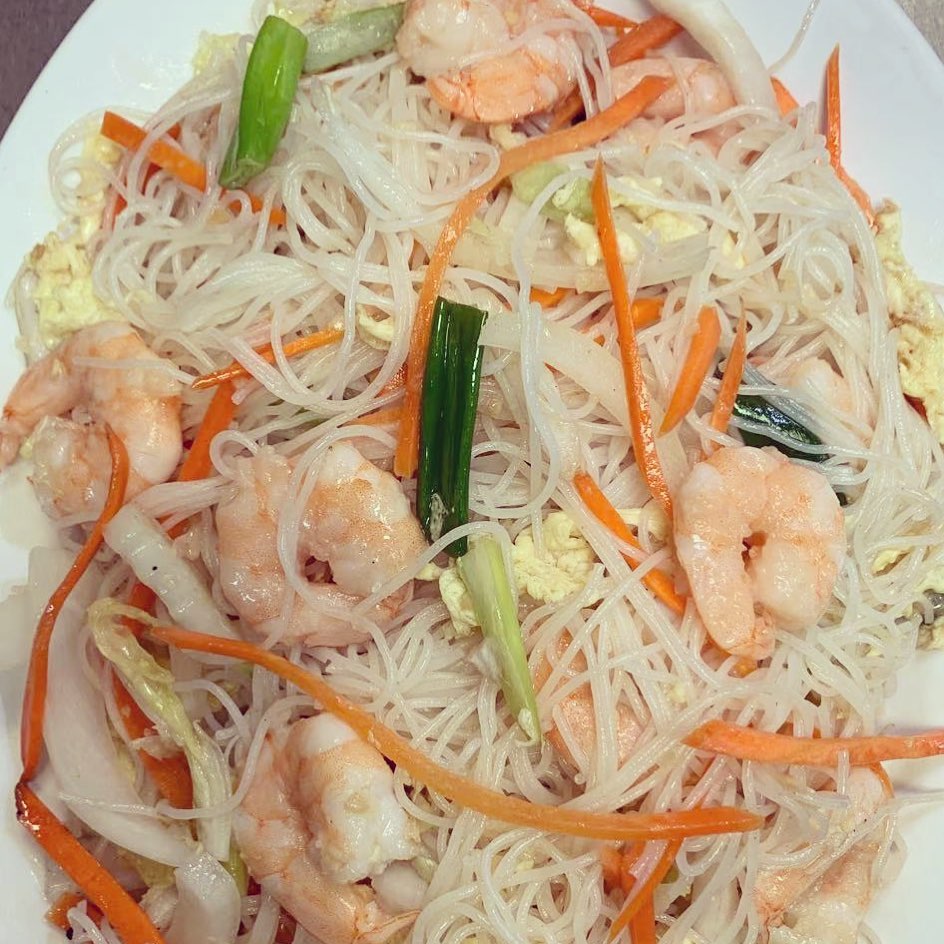
Shrimp Mei Fun can be healthy when prepared with the right ingredients, cooking methods, and portion sizes. Here are some factors to consider:
- Ingredients: Shrimp provides a good source of protein while being relatively low in calories and saturated fat. Rice noodles offer a gluten-free option and can be lower in fat compared to wheat-based noodles. Including an array of vegetables adds fiber, vitamins, and minerals to the dish.
- Cooking Methods: Stir-frying Shrimp Mei Fun using minimal oil helps to keep the overall fat content lower. Cooking over high heat ensures that the vegetables retain their nutrients and vibrant colors.
- Portion Sizes: Controlling portion sizes is key to maintaining a healthy balance. Enjoying Shrimp Mei Fun as part of a well-rounded meal with a variety of nutrients is recommended.
- Customization: Shrimp Mei Fun can be customized to fit personal preferences and dietary needs. Adjusting ingredient quantities and choosing low-sodium sauces or healthier alternatives can contribute to a healthier dish.
Remember, moderation is key. By being mindful of the ingredients, cooking techniques, and portion sizes, Shrimp Mei Fun can be enjoyed as a delicious and relatively healthy option within a balanced diet.
What to serve with shrimp mei fun?
Shrimp Mei Fun pairs well with a variety of accompaniments that complement its flavors and provide a well-rounded meal. Here are some options to consider:
- Steamed Vegetables: Serve a side of steamed broccoli, bok choy, or mixed vegetables to add freshness and additional nutrients to the meal.
- Egg Rolls: Enjoy crispy egg rolls as an appetizer or side dish. Their savory fillings and crunchy texture complement the soft and flavorful Shrimp Mei Fun.
- Hot and Sour Soup: Start the meal with a bowl of hot and sour soup, a classic Chinese soup known for its tangy and spicy flavors. It provides a contrast to the noodle dish while offering a warm and comforting element.
- Stir-Fried Greens: Sautéed spinach, Chinese greens, or gai lan make excellent side dishes to balance the flavors of Shrimp Mei Fun. Their tender texture and vibrant colors add visual appeal to the meal.
Variations of shrimp mei fun
Shrimp Mei Fun noodles can be customized and personalized to suit individual preferences. Here are a few variations you can try:
- Vegetable Mei Fun: Increase the vegetable content by adding a colorful mix of bell peppers, carrots, snap peas, and mushrooms. This variation adds extra nutrition and a delightful crunch to the dish.
- Spicy Shrimp Mei Fun: For those who enjoy a kick of heat, add some diced chili peppers or a drizzle of chili oil to the dish. This variation adds a spicy element that elevates the flavor profile of Shrimp Mei Fun.
- Garlic Shrimp Mei Fun: Boost the garlic flavor by adding additional minced garlic during the cooking process. The aromatic garlic enhances the overall taste of the dish.
- Sesame Shrimp Mei Fun: Drizzle a bit of sesame oil over the cooked Shrimp Mei Fun and sprinkle toasted sesame seeds on top. This variation imparts a nutty aroma and adds an extra layer of richness.
- Teriyaki Shrimp Mei Fun: Toss the cooked shrimp and noodles in a homemade teriyaki sauce, combining the savory flavors of soy sauce, ginger, and garlic. This variation adds a sweet and tangy twist to the dish.
- Lemon Shrimp Mei Fun: Squeeze fresh lemon juice over the cooked Shrimp Mei Fun for a burst of citrusy flavor. This variation offers a refreshing and vibrant taste.
Substitute ingredients about shrimp mei fun
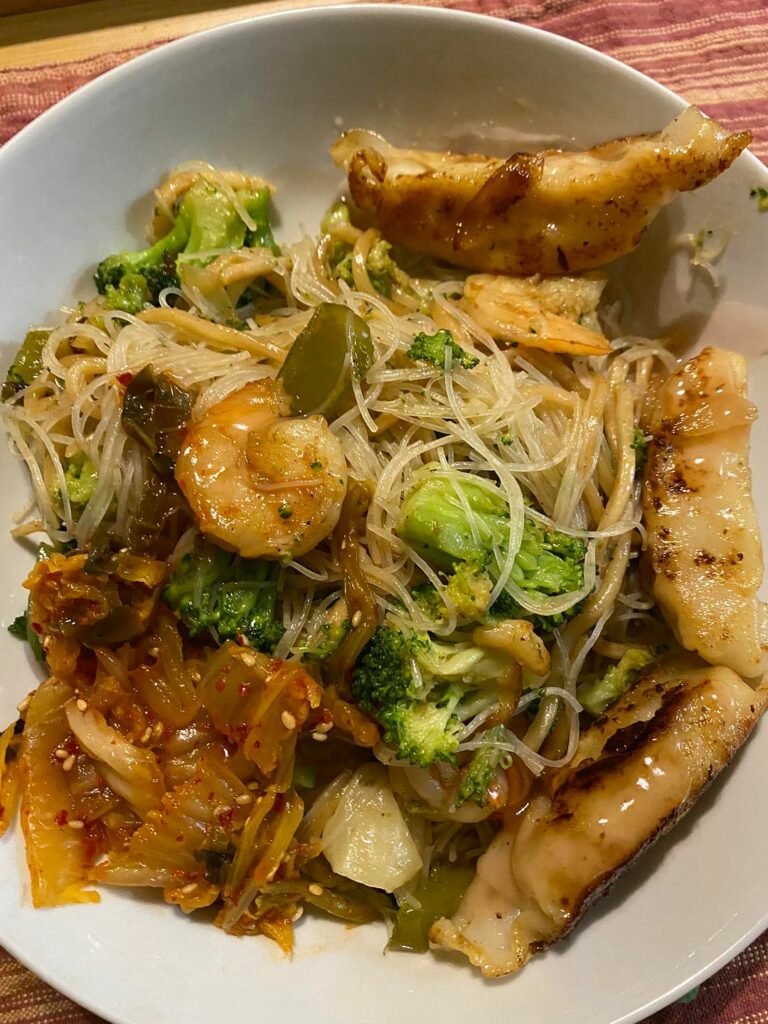
If you’re looking to make variations or accommodate dietary preferences, here are some ingredient substitutions you can try in Shrimp Mei Fun:
Protein
- Tofu: Swap the shrimp with cubed tofu for a vegetarian or vegan version of Shrimp Mei Fun. Make sure to press the tofu to remove excess moisture before stir-frying.
- Chicken Mei Fun: Substitute the shrimp with diced chicken breast or thigh for a different protein option. Cook the chicken until it is fully cooked and no longer pink in the center.
Noodle
- Egg Noodles: If rice noodles are not available, use egg noodles as a substitute. They provide a different texture and flavor, but still work well in the dish.
- Zucchini Noodles: For a low-carb option, replace the rice noodles with spiralized zucchini noodles. Keep in mind that zucchini noodles may require a shorter cooking time.
Vegetable
- Snow Peas: Swap snap peas with snow peas for a slightly sweeter and crunchier alternative.
- Baby Corn: Add baby corn for a unique texture and slightly sweet taste. Slice them into bite-sized pieces before stir-frying.
- Bok Choy: Substitute the bean sprouts with bok choy leaves or baby bok choy for a nutritious leafy green addition.
Sauce
- Tamari or Coconut Aminos: Replace soy sauce with tamari or coconut aminos to make a gluten-free version of Shrimp Mei Fun.
- Hoisin Sauce: Add a touch of hoisin sauce for a hint of sweetness and depth of flavor. Adjust the amount based on personal preference.
How to store shrimp mei fun?
If you have leftover Shrimp Mei Fun or need to store it for later consumption, follow these guidelines for proper storage:
Cool down
Allow the Shrimp Mei Fun to cool down to room temperature before storing it. Leaving it out for too long at room temperature can promote bacterial growth.
Refrigeration
- Transfer the Shrimp Mei Fun to an airtight container or sealable plastic bag.
- Place it in the refrigerator and make sure it is stored within 2 hours of cooking. Proper refrigeration helps to maintain its freshness and quality.
- Shrimp Mei Fun is best consumed within 1–2 days of preparation. As time passes, the texture of the noodles may change and the flavors may diminish.
Reheating
When ready to enjoy the leftovers, gently reheat the Shrimp Mei Fun in a skillet or microwave until heated through. Add a splash of water or broth if needed to prevent it from drying out.
Note: It’s important to exercise caution when reheating shrimp to avoid overcooking and compromising its texture. Overcooked shrimp can become rubbery and less enjoyable.
Common mistakes when making shrimp mei fun
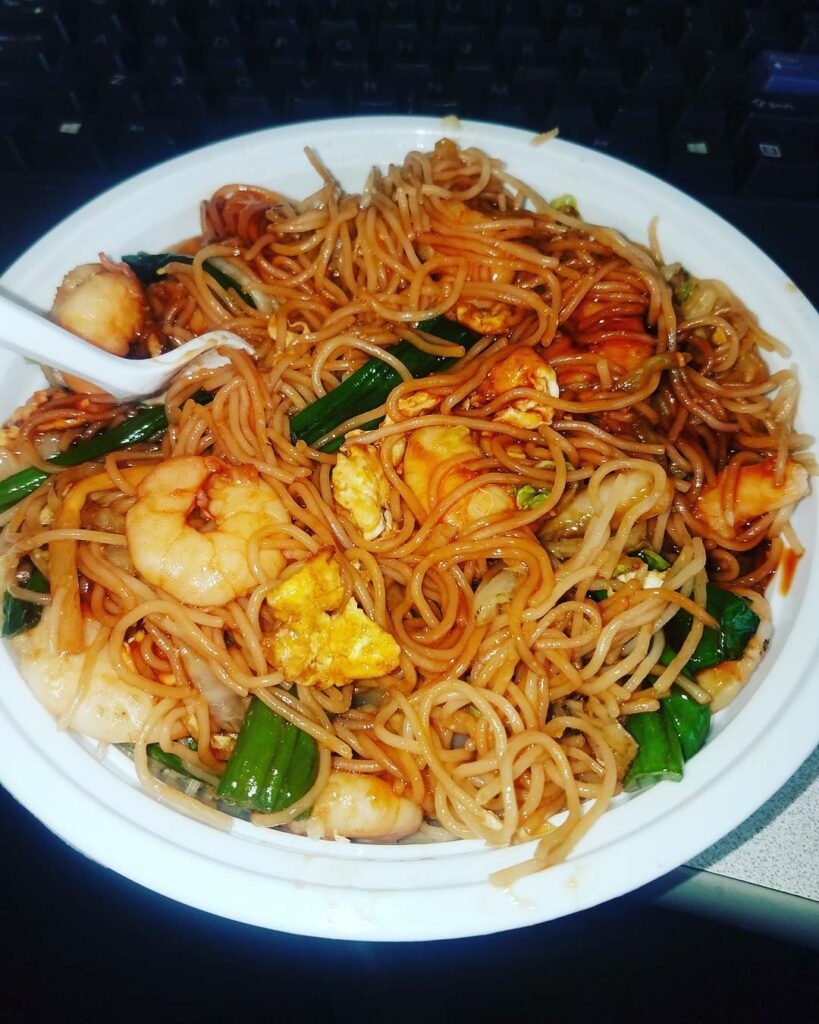
While preparing Shrimp Mei Fun, there are a few common mistakes to avoid ensuring the best outcome:
- Overcooking the Shrimp: Shrimp cook quickly, and overcooking them can result in a rubbery texture. Cook the shrimp just until they turn pink and opaque to maintain their tenderness.
- Over-soaking or Under-soaking Rice Noodles: Follow the instructions for soaking rice noodles carefully. Oversoaking can make them mushy, while undersoaking can leave them too firm. Aim for a slightly al dente texture.
- Not Prepping Ingredients in Advance: Shrimp Mei Fun is a stir-fry dish that requires quick cooking. Prepping all the ingredients in advance, such as chopping vegetables and having the sauce ready, ensures a smooth cooking process.
- Overcrowding the Pan: Stir-frying works best when the ingredients have space to cook evenly. Overcrowding the pan can lead to uneven cooking and steaming instead of stir-frying. Cook in batches if needed to avoid this mistake.
- Neglecting Seasoning Balance: Shrimp Mei Fun relies on a delicate balance of flavors from the seasonings. Taste and adjust the amount of soy sauce, oyster sauce, and other seasonings to achieve the desired balance of savory, umami, and sweetness.
- Overcooking Vegetables: Vegetables should be stir-fried until they are slightly tender yet crisp. Overcooking them can result in a loss of texture and vibrant color. Pay attention to the cooking time for each vegetable and adjust accordingly.
Tips for perfecting shrimp mei fun
Tips for Perfecting Shrimp Mei Fun
- Preheat the Wok or Skillet: Ensure that your wok or skillet is properly preheated before adding any ingredients. A hot cooking surface helps to achieve a nice sear and prevents sticking.
- Use High Heat: Stir-frying Shrimp Mei Fun requires high heat to quickly cook the ingredients while preserving their textures and flavors. This helps to achieve a vibrant and crisp dish.
- Prepare Ingredients in Advance: Practice mise en place by preparing and organizing all the ingredients before you start cooking. This will ensure a smooth and efficient cooking process.
- Cook Shrimp Separately: For the best texture and flavor, consider stir-frying the shrimp separately from the other ingredients. This allows you to control the cooking time precisely and avoid overcooking the shrimp.
- Control Sauce Quantity: Start with a modest amount of sauce and gradually add more if needed. This prevents the dish from becoming too saucy or overpowering the other ingredients.
- Add Vegetables in Stages: Different vegetables have varying cooking times. To ensure that they are cooked perfectly, add them in stages according to their required cooking times. Start with the ones that take longer and add the quicker-cooking vegetables towards the end.
- Finish with Fresh Herbs or Scallions: Just before serving, sprinkle some fresh herbs like cilantro or finely sliced scallions on top of the dish. This adds a pop of freshness and brightens the flavors.
- Garnish and Presentation: Pay attention to the final presentation of your Shrimp Mei Fun. Consider adding a garnish of toasted sesame seeds or a drizzle of sesame oil to enhance both the appearance and taste of the dish.
- Personalize with Additional Ingredients: Feel free to customize your Shrimp Mei Fun with additional ingredients such as sliced mushrooms, bamboo shoots, or water chestnuts. This allows you to experiment with different flavors and textures.
FAQs
How to pronounce shrimp mei fun?
To pronounce “Shrimp Mei Fun,” you can break it down as follows:
- Shrimp: Pronounced as “shrimp” (rhyming with “limp”).
- Mei: Pronounced as “may” (rhyming with “say”).
- Fun: Pronounced as “fun” (rhyming with “sun”).
Put it all together, and it is pronounced as “shrimp may fun.”
How fattening is shrimp mei fun?
The calorie and fat content of Shrimp Mei Fun can vary based on the specific recipe and portion size. However, Shrimp Mei Fun is generally considered a relatively healthy dish when prepared with lean protein, a moderate amount of oil, and a good balance of vegetables.
The dish typically contains a moderate number of calories and can be a good source of protein. To control the overall calorie content, portion sizes and the use of excessive oil or sauces should be monitored.
It is always advisable to consider your specific dietary needs and consult with a healthcare professional for personalized advice.
Are Shrimp Mei Fun noodles gluten-free?
Shrimp Mei Fun noodles are typically made from rice, which is naturally gluten-free. However, it’s important to check the specific brand or type of noodles you are using, as some may be processed in facilities that also handle gluten-containing ingredients.
If you have gluten intolerance or sensitivity, it is recommended to look for certified gluten-free rice noodles or alternative gluten-free noodle options to ensure they are safe for consumption.
Can I use frozen shrimp for Shrimp Mei Fun?
Yes, you can use frozen shrimp for Shrimp Mei Fun. Before using frozen shrimp, make sure to properly thaw them according to the manufacturer’s instructions or by placing them in the refrigerator overnight.
Once thawed, pat the shrimp dry with paper towels before cooking. Using frozen shrimp can be convenient and still provide delicious results in your Shrimp Mei Fun dish.
What type of wok or skillet should I use for Shrimp Mei Fun?
For cooking Shrimp Mei Fun, it is recommended to use a wok or a large skillet. A carbon steel or non-stick wok is a popular choice as it allows for even heat distribution and quick stir-frying.
A skillet with a wide surface area and high sides can also work well. The important aspect is to use a pan that can withstand high heat and has enough space to toss and stir-fry the ingredients effectively.
Does Shrimp Mei Fun contain MSG?
The use of MSG (monosodium glutamate) in Shrimp Mei Fun can vary depending on the specific recipe and personal preference. While some recipes or commercially prepared sauces may contain MSG, it is not an essential ingredient in Shrimp Mei Fun.
If you prefer to avoid MSG, you can make your own sauces or look for MSG-free options when using store-bought sauces or condiments. By preparing Shrimp Mei Fun from scratch, you have full control over the ingredients and can adjust them according to your preferences and dietary needs.
Can I make a keto-friendly version of Shrimp Mei Fun?
Yes, it is possible to make a keto-friendly version of Shrimp Mei Fun by making a few adjustments. Instead of using rice noodles, you can substitute them with low-carb alternatives like zucchini noodles (zoodles) or shirataki noodles. These options are low in carbs and can fit well into a keto diet.
Additionally, ensure that the sauces and seasonings you use are also keto-friendly, avoiding ingredients with added sugars or high carbohydrate content. By modifying the ingredients to be low in carbs and choosing keto-approved options, you can enjoy a delicious keto-friendly version of Shrimp Mei Fun.
Can I make a dairy-free version of Shrimp Mei Fun?
Yes, it is possible to make a dairy-free version of Shrimp Mei Fun. Traditional Shrimp Mei Fun recipes do not typically include dairy products. However, it’s important to check the specific recipe or sauces you plan to use, as some pre-made sauces or condiments may contain dairy or dairy-derived ingredients.
By choosing dairy-free sauces and seasonings, you can easily prepare a dairy-free version of Shrimp Mei Fun. Additionally, using vegetable oil instead of butter or ghee can further ensure the dish remains dairy-free.
How to know shrimp is cooked?
Properly cooked shrimp should have a firm, opaque appearance, and a slightly curled shape. Here are a few indicators to know when shrimp is cooked:
- Color: Shrimp change color as they cook, transforming from gray or translucent to pink or orange. Look for a consistent color throughout the shrimp.
- Texture: Cooked shrimp should have a slightly firm and springy texture when you touch them. Avoid overcooking, as it can result in a rubbery texture.
- Shape: Shrimp will naturally curl as they cook. When they form a loose “C” shape and the tails tuck inwards, it indicates that they are cooked.
- Time: The cooking time for shrimp varies depending on the size and cooking method. In general, shrimp cook quickly, typically requiring 2-3 minutes per side when sautéed or stir-fried, or 4-5 minutes when boiled.
What kind of sauce is best with shrim mei fun?
The choice of sauce for Shrimp Mei Fun depends on personal preference and desired flavor profile. However, one popular and delicious sauce option is a combination of soy sauce and oyster sauce.
This combination provides a savory and umami-rich base that complements the flavors of the shrimp, noodles, and vegetables in Shrimp Mei Fun. You can adjust the ratio of soy sauce to oyster sauce to suit your taste, or even add a touch of sesame oil or other seasonings for added depth of flavor.
The best sauce for Shrimp Mei Fun is one that enhances the overall dish and brings out its delicious flavors, so feel free to experiment and customize the sauce to your liking.
Conclusion
Upon further analysis, Shrimp Mei Fun, a beloved Chinese noodle dish, offers a tantalizing culinary experience with its harmonious blend of flavors, textures, and vibrant ingredients. From the succulent shrimp to the delicate rice noodles, this dish embodies the artistry and diversity of Chinese cuisine. Whether enjoyed in a bustling restaurant or prepared at home, Shrimp Mei Fun showcases the mastery of stir-frying and the careful balance of seasonings.
We’ve explored the origins, taste, and health aspects of Shrimp Mei Fun, discovering its cultural significance and versatility. Through our comprehensive guide, you’ve learned how to pronounce it correctly, its caloric content, and even variations to suit different preferences. We’ve provided tips for perfecting the dish, emphasizing the importance of ingredient preparation, cooking techniques, and personalization.
Now armed with knowledge and expertise, you can embark on your own culinary journey with Shrimp Mei Fun. Impress family and friends with your skills as you recreate this flavorsome dish, experimenting with different combinations and substitutions to make it your own.
More Cantonese style stir-fried noodles recipe